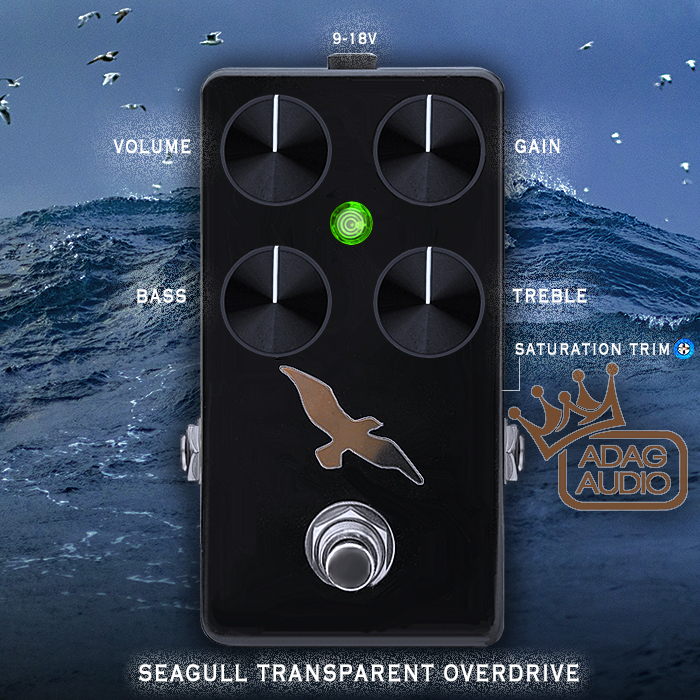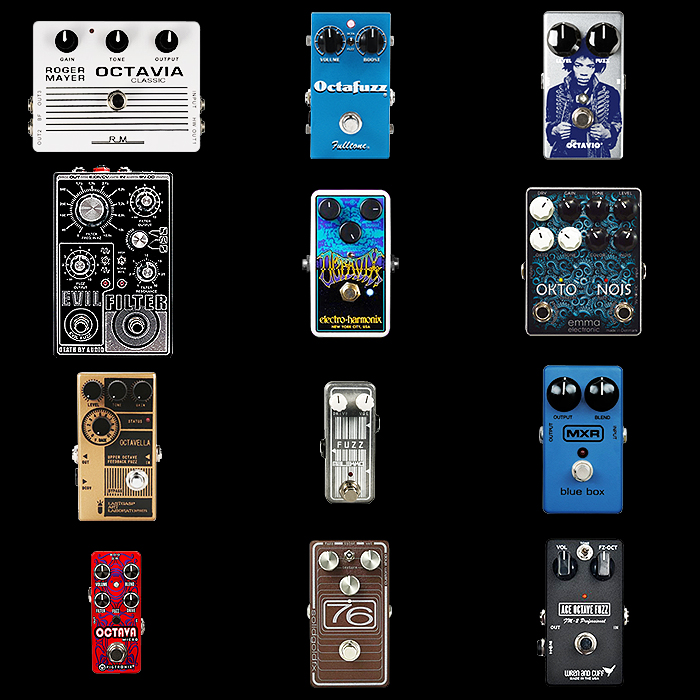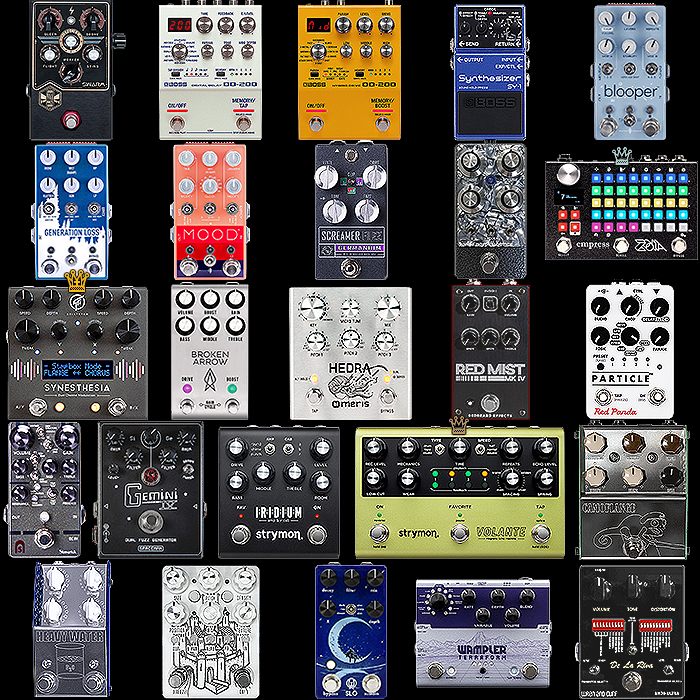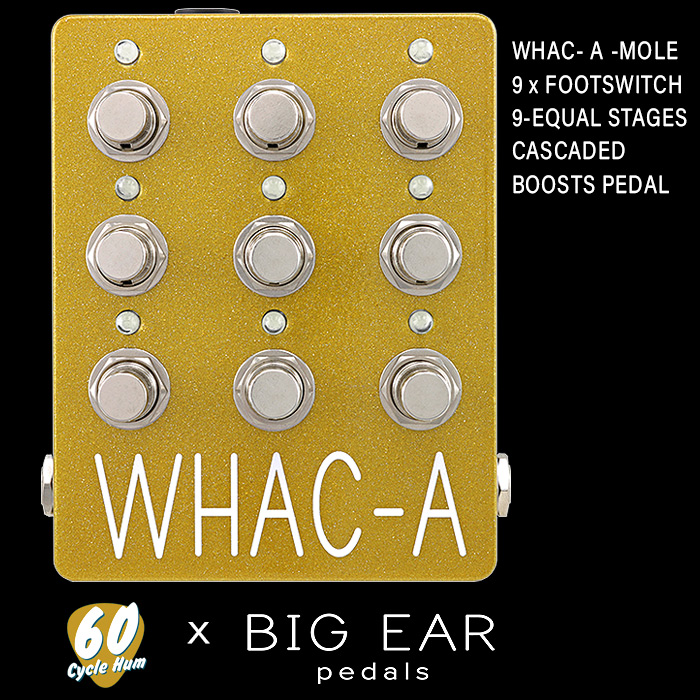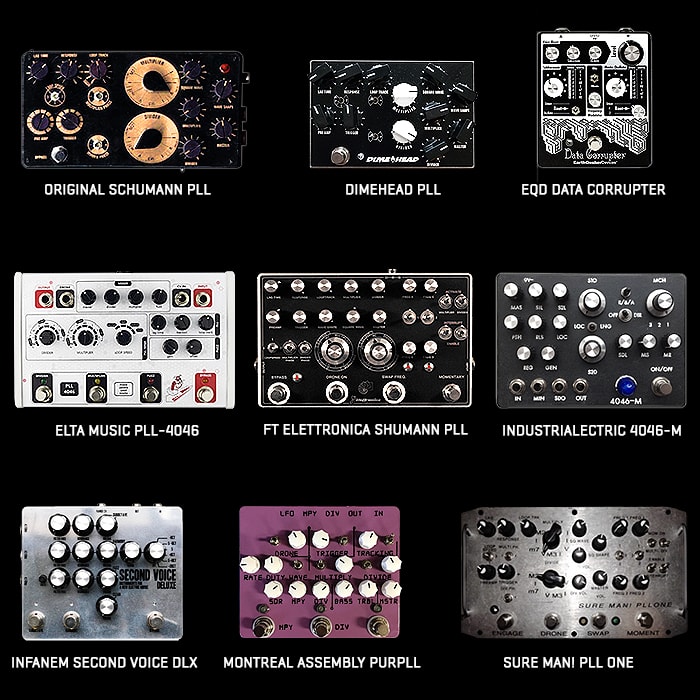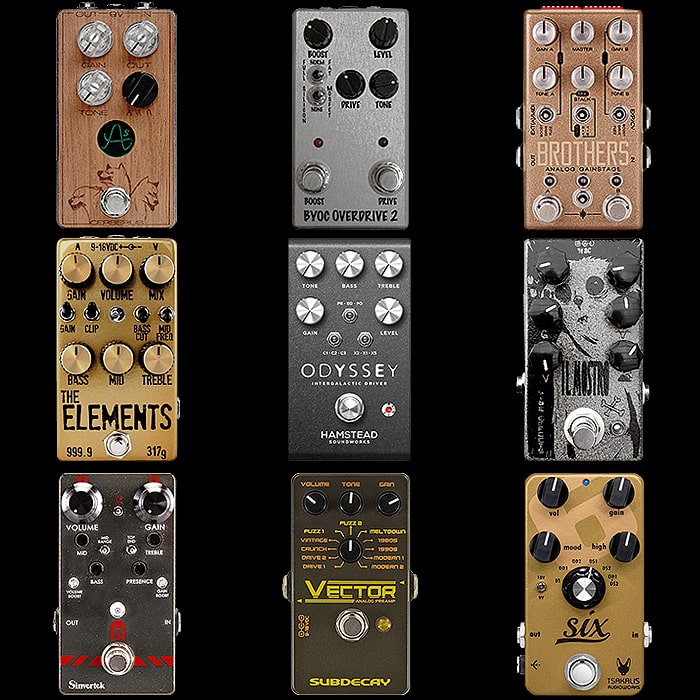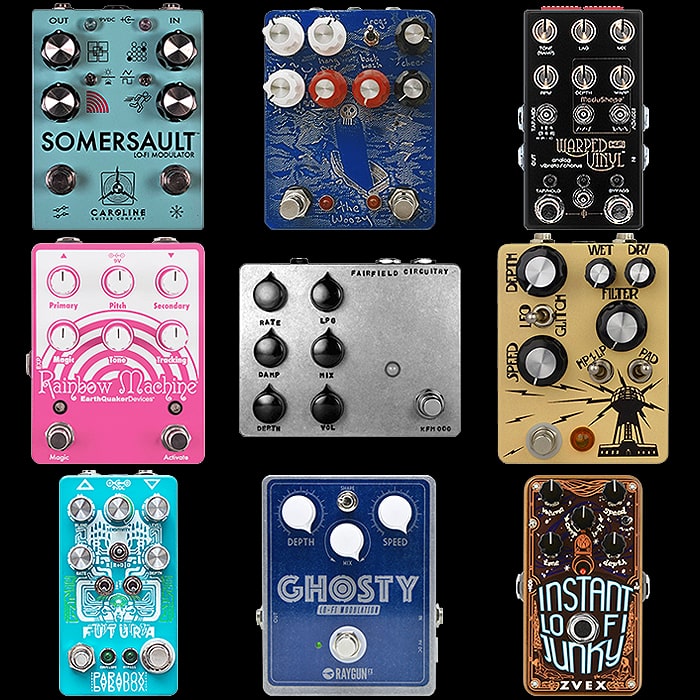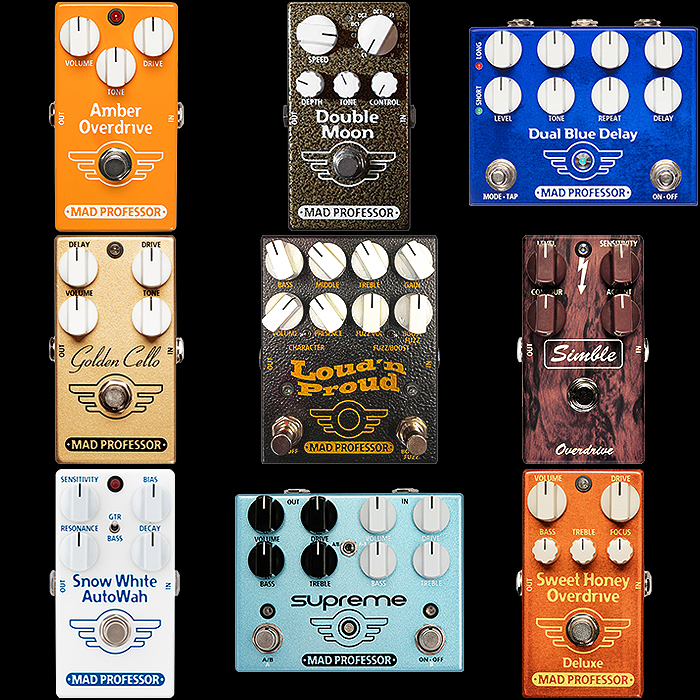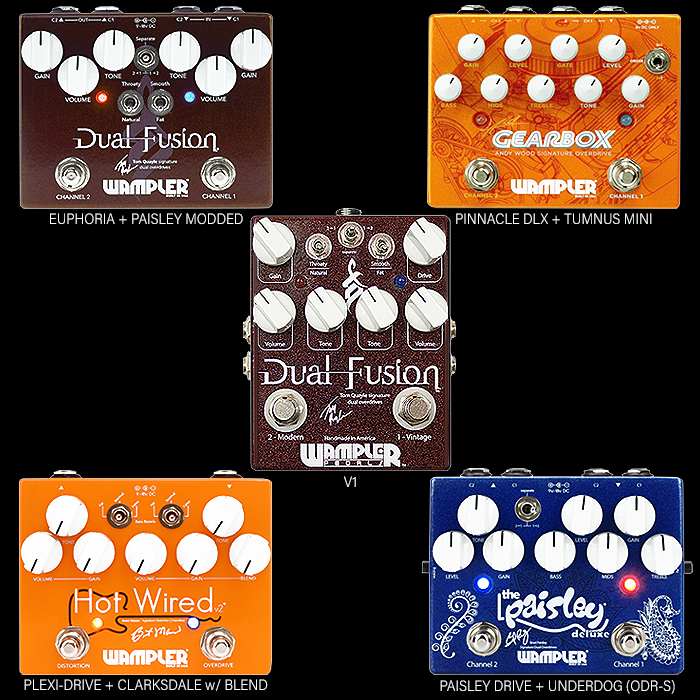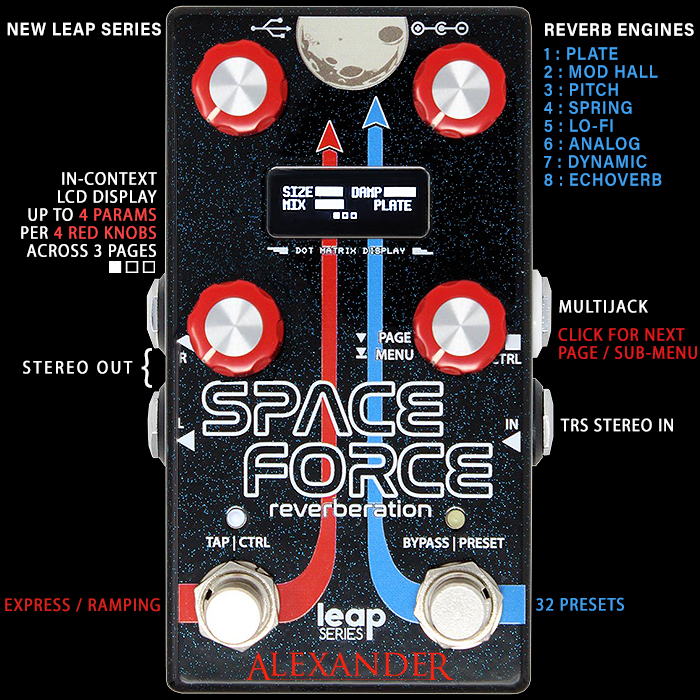Favourite Pedals released in and around Summer NAMM 2019

I have covered off a number of my favourite Summer NAMM pedals already - including the Boss 200 range, RC-10R and SY-1, the Fulltone OCD Ge, the REVV G2, the Spaceman Effects Gemini IV, and Walrus Audio Kangra for instance. And there’s a couple more surprise ones I will be posting as dedicated features very soon - so stay alert for those! In the wake of one of the best ever Winter NAMM’s it was clear that the Summer NAMM could never match that degree of innovation - in fact most of the Summer NAMM innovations were on guitars - and I will do a separate post later on some of my favourites from that area.
Generally, besides Delicious Audio, Premier Guitar and Reverb.com, coverage for Summer NAMM has been a little lacklustre this time around - and there are still several of the new pedals missing featured or demo videos. I had to exclude some of my preferences in this regard as the material collateral available for them was just too inadequate. I’ve tried to include everything in my Longlist below, but I will undoubtedly have overlooked a few - and this post will quite likely be updated a few times after it goes live.
In any case I’ve picked out 16 of my favourite pedals from this show to highlight - with the longlist covering all those I left out. Most of my favourite new pedals here are somewhat revisions of previous favourites - and I’ve included the Wampler Terraform again as it is now in its final production model with all the algorithms properly defined and refined.
My most likely acquisitions here are in order of preference - the Sinvertek N5 Plus, Gamechanger Plasma Coil Third Man Records Edition, and the 4 mini Dunlop Hendrix Psych Series pedals. I’m also somewhat intrigued by the Big Ear Albie - for which details are somewhat scant at the moment, but I expect more to materialise any day now.
Pedals are listed in alphabetical order by brand as usual:
Alexander Pedals Marshmallow Artificial Sweetener 6-Mode Pitch-Shifter - £199
Yet another really cool super-tweakable Alexander Pedal, this time focusing on Pitch-Shifting - with 6 cool algorithms - MOD (Dual pitch shift with adjustable pitch modulation), ARPY (Arpeggiator), RAND (Dual pitch shift with random modulation), RING (Dual pitch shift with automatic panning between the two signals), DYNA (Dynamic Pitch Shifter), and CLOUD (Dual pitch shift with adjustable feedback, for reverb-like washes and echoes). The Marshmellow contains all the usual Alexander NEO benefits - Onboard Presets, Alternative Functions, Midi Control etc. with the second Footswitch in this instance offering Quantizing/Pitch Lock functionality. No doubt a really versatile Pitch-Shifter which I prefer in its 'Toasted Orange' livery as pictured. It's timing isn't perfect as it launches into the wake of the Meris Hedra - another really capable Pitch-Shifter/Delay with all manner of secondary features. I'm one of the multitude that sprung for a Hedra - so the Marshmallow has somewhat less appeal for me - even though it largely does different things. I'm not sure I would accommodate 2 Pitch-Shifter in my already busy chain - so this is likely to take something of a backseat for a while - particularly based on how much I'm enjoying using/deploying the Hedra at the moment.
Big Ear Pedals Albie Multi-Multi Effect! (x8) - £200 Est.
This is one of those could be / should be really cool pedals, but there are scant details available at the moment and no videos as yet. Essentially this pedal is billed as 8 different effects chains - i.e. each of the Effect selections is combination of several effects in unison - where the only fine-tune you have is a blend knob! Big Ear describes it as : “What does it do?! What’s an ALBIE?” Simply put, ALBIE is the sound of New Wave.. A box full of ambience and modulation... a collection of “stacks” or “chains” of effects. So we're not actually clear how this works - but the understanding is that each 'effect stack' is fully dialled-in and refined - and all you do is select the degree to which is is applied to your signal chain. I've already said that I feel that this is a new trend for effects pedals - where instead of having to hunt for 'sweet-spots' across 5 or more dials - the various Voices or actual sweet spots can be arrived at via uniform / universal selected - where you then just fine-tune to taste - so a more modern / progressive route to guitar effects therefore. NOTE - no video yet, will update as soon as one materialises.
Dunlop Hendrix '69 Psych Series Band of Gypsys Fuzz Mini - £139
These are priced somewhat unfairly in the UK, as US RRP is £129 which usually results in a $ to £ parity - even though including taxes, the pound currency equivalent would be a lot less. I've mentioned before how Meris do a similar thing - I'm not really happy with it, and it taints my experience of those brands. Meris in the US for instance is $299, in the UK $319 - which is just wrong for all sorts of reasons. In any case concerning the new Hendrix '69 Psych Series - Dunlop have really pushed the boat out with these pedals - adding in new features over the last time this signature range was re-launched a couple of years ago. In fact the Band of Gypsys Fuzz and the Uni-Vibe remain functionally the same - while the Fuzz Face and Octavio Fuzz are enhanced. The circuits have been miniaturised - but Dunlop assures us that they use the same key components to generate the tone. I have a feeling I might just collect the whole set! I really think Dunlop should package all 4 into a set and put an attractive price on it!
Dunlop Hendrix '69 Psych Series Fuzz Face Mini - £139
I feel this is going to be the big-seller here - Dunlop have thrown in a Buffer switch, and a SI/GE Option Switch - most likely achieved with diodes rather than dual pairs of transistors - but still very cool. I'm a huge Fuzz Face fan, and really like the look of this mini - sounds pretty impressive too in the demos!
Dunlop Hendrix '69 Psych Series Octavio Fuzz Mini
There is no individual video for this one - please refer to either of the above 2 videos which cover all 4 pedals within this new '69 Psych Series. The Octavio is another enhancement - with a separate push-button 'Octave' switch to add or remove that element. I have the compact Octavio predecessor to this - but the Mini makes more sense with that button. Not sure how it stacks up against my current favourite Mini Octave Fuzz - the Pigtronix Octava Mini - but we shall see.
Dunlop Hendrix '69 Psych Series Uni-Vibe Mini
No separate video for the Uni-Vibe Mini - please refer to the above 2 '69 Psych Mini Series videos which cover all 4 varieties. Beyond the miniaturisation here there are no obvious enhancements - has the same Chorus/Vibrato switch as on its predecessor - the advantage is obviously in its size. Like I said above I like all 4 minis here, and am likely to acquire all eventually - Dunlop should really consider having these all boxed up in a set if they haven't done so already!
Dwarfcraft Devices SheFuzz V3
Dwarfcraft's SheFuzz started off as the Shiva Fuzz many years ago as a medium-enclosure fuzz - it then morphed into the same size V1 SheFuzz, before becoming more compact and practical in its current modern format. The previous colour way has quite a more ebullient style of graphics, while for the V3 we're on to to a more pared-down approach - this time I believe built by Pinebox Customs for Dwarfcraft. SheFuzzes are always released in very small batches - of around 50 units - which pretty much get snapped up immediately which I believe is the case here too. The pedal features 3 knobs - Power (Starve degree), Texture (Saturation), Volume; then 3 toggle switches - Starve, Octave, Comp and dual-footswitches - the left hand one of which allows you to control the Starve component via momentary switching means. It's a really cool compact fuzz - and of course I'm tempted - I may though just for fun try to hoover up its predecessor or just bide my time on Reverb.com until one such becomes available - not a pressing priority for me in any case.
Gamechanger Audio Third Man Records Plasma Coil Pedal Limited Edition $300 (Black) / $350 (Limited Yellow - as pictured)
Following on from Jack White's Third Man Records collaboration with Mantic FX on a special edition Flex PLL pedal, they are now collaborating with Gamechanger Audio on a very special edition of the Plasma Coil pedal - which switches out the central Blend knob for a 6-way boost and octaves mode switch = Booster, -1 Octave, -2 Octaves, Octave Up, Octave Up and Down, Octave Up and -2 Down. When the plasma was originally launched as a style of distortion - I somehow felt disconnected with it, as it always sounded to me as a somewhat gated fuzz. I'm the kind of guy who likes to run his fuzz pedals on full throttle, so I really don't bemoan the Blend knob - while the new Mode Options including a secondary footswitch for applying those modes in momentary as well as latching fashion - make this pedal that more appealing for me. To such an extend that I've already sent and inquiry to Third Man Records, as their website order form is only for US Customers!
Greer Amps Gorilla Warfare MKII LM308 Distortion - £199
I'm a massive Rat pedal fan - with 12 or 13 now already in the collection - and a JAM Pedals TPS Rattler imminent too. It's always nice to see a new take on the format - this one using authentic LM308 chip - and reversing the sweep of the Filter knob - so that it acts in the more common additive rather than subtractive fashion. Obviously this is Nick Greer's take on the circuit - which is suitably musical as always - he may have overly tamed those distortion harmonics a touch though as seems evident on early demo videos - but I'm prepared to give this a chance to prove itself. With all the many modern derivations of the Rat - with 3-Band EQ's and the like - I sometimes find it rather unsettling to see very plain 3-knob iterations of the Rat - per the recent EHX Flatiron (still waiting on JHS Mod!), and as per this Greer take too. I'm not sure if I could justify the acquisition of this one - it has to offer something notable different from my existing varieties, and I'm not entirely sure that it does?
Korora Audio Merlo Harmonic Tremolo - $249 Est.
I have mentioned the Korora Audio Spira a couple of times on this site, and this is said builder's follow up to that - the Merlo Tap-Tempo Harmonic Tremolo. It's another cool take on the format, and would undoubtedly feature in my Harmonic Tremolo pedals overview had it arrived in time for that. I feel that it won't necessarily knock out my top contenders - the Chase Bliss Audio Gravitas, Flower Pedals Dandelion and Walrus Audio Monument V2 - but it is certainly a notable alternative. Korora Audio pedals tend to be very well tuned in any case, and you may decide you prefer the core tonality of this pedal - which is what draws so many to the Supro Tremolo - despite its rather limited feature set.
Mad Professor Supreme Matt Schofield Signature Dual Overdrive (Royal Blue+) - £219
Just watch the above video for the insider's view on the pedal as Matt explains himself how his new signature pedal came about. The A side / channel here is essentially the Royal Blue Overdrive - which Matt uses to enhance the high frequencies for his clean / always on tone, while the B side / channel is an entirely new circuit - in effect a less compressed, higher headroom version of the Twimble/Simble circuit - or sort of Dumble ODS-style. My good friend Sof is something of a fan of Mad Professor - and their Twimble pedal in particular, and has the Supreme on pre-order. You can play the A and B channels individually, or you can choose to stack them - depending on where you set the centre toggle switch selector.
Mythos Pedals Argonaut Octave Fuzz Mini - $119/£119
I am already a fan of the Mythos Mini Fuzz pedals in particular - having had both the Golden Fleece and Joey Landreth High Road pedals for a while. They may we be joined by this mini part-version of the larger Argo Octave Fuzz - this being just the ring-mod style octave element from that. I'm undecided as to whether I go for the full-size full-featured Argo version or just use the Argonaut in conjunction with my existing fuzzes - right now I am somewhat leaning more towards the Argo - but we shall see. There are no demo videos of this pedal yet - will add when one materialises.
Mythos Pedals Typhon Dual Overdrive Wildwood Guitars Special - $249
A novel and deliberate mis-spelling of Python - judging from the snakeskin-patterned enclosure. This is a collaboration with Wildwood Guitars, and is essentially a derivation of the Herulean V2 pedal - itself an evolution of the TS808 genre. Side A is a modified version of our Herculean V2 circuit as mentioned, while Side B is another Op Amp based drive that has huge headroom and less of a mid forward voicing. Side A features Mosfet clipping while Side B has Asymmetrical Silicon clipping. It is an A/B either/or pedal and does not accommodate stacking - which for me is a shame as I really enjoy gain stacking these days! Again, no demo video out yet and pedal can only be acquired from the Wildwoodguitars.com site - currently on pre-order.
Sinvertek N5 Plus Drive - $199
I have both the predecessors to this pedal - the No.5 Distortion, and the more recent N5 Drive - and this takes that fantastic control topology even further. At their heart these pedals have 4-band EQ (including Presence) with all manner of clever further voicing switches, along a really smart progressive boost system - all achieved via just the single footswitch. Where one press activates the pedal, and the second press activated the boost - which you can then alternate between with single presses - a quick double press and the pedal is by-passed etc. In any case - the N5 has only been out officially now for less than a year - before this even more impressive pedal has arrived on the scene - due to ship September I believe - via usual Reverb.com and Ebay sites. The new pedal has 7 dials now - where the 4-band EQ (including Presence) is joined by a Resonance Control. On the previous pedals the mini dials were somewhat fiddly in use - but now we have proper knobs on all dials and no less than 5 further option toggle switches - which is two more than on the predecessors. There are 4 3-way toggles controlling Gain Structure, Low End, Top End and Mid Range. And the usual Boost Mode up/down selector is now placed much further down - between the Resonance and Presence Knobs. The No.5 and N5 are already formidable pedals in their own right - but this here is a whole new ball-game - possibly a little fiddly for some - but looks incredibly for a tone-tweaker for me. Probably this pedal is starting to need Presets now too! I am guessing the pictures are early prototypes, as there are no demo videos available yet - will add when they materialise. In the meantime I've assigned the superb Pete Thorn demo of the N5 drive.
Source Audio C4 4-Voice Modular Synth - £249
Even though I feel that the C4 has been somewhat gazumped by the recently announced Boss SY-1 Synth with its 121 flavours onboard versus the C4's 6, while the C4 has several more aces up its sleeve - depending on how you feel about using Apps extensively to model your pedal. The C4 is in fact a fully modular Eurorack-style 4-Voice Synth in pedal format - and the 4 dials and 3-way toggle are just the tip of the iceberg. With the Mobile and Desktop Neuro Apps you can model every part of they synt's signal path - selecting and combining difference core voicings and adding a significant variety of modulations - not altogether dissimilar to what you do with a TC Electronics TonePrint. So in this regard it really depends how familiar and comfortable you are with creating your own presets in an App - versus Boss's more immediate hands-on approach. The C4 is obviously far more tweakable overall, but does rely entirely on external apps for that flexibility. Still very much a contender!
Wampler Terraform Modulation Workstation - £299 Est.
Even though Wampler have confirmed the final configuration of the Terraform pedal we still don't know how good it sounds : Auto-Wah | Envelop Filter | Flanger | Phaser | U Vibe | Rotary | Auto Swell | Tremolo | Harmonic Tremolo | Chorus | Dimension versus the Winter NAMM 11 algorithms of : Additive Flanger | Subtractive Flanger | TZ Flanger | 90 Phase | Vibe | Slow | Tremolo | Harmonic Tremolo | Dimension C | 3-Voice Chorus | Chorus. So it certainly looks more rounded on the surface, and the above picture is of the final production model - while there are no demo videos of that version yet. I have some reservations in the way the jacks are side-mounted, and how Wampler is using the same push-button design of Presets as Source Audio has on its Nemesis and Ventris pedals. I also feel that the Terraform has been somewhat gazumped by the superior form factor of the forthcoming Boss MD-200 - but more of that later. People will buy this pedal largely on the performance of their favourite modulations - and how closely this unit matches those - with Harmonic Tremolos and Uni-Vibes being particular hot potatoes of the moment. We still don't yet know how well either the Wampler or Boss unit will shape up eventually - will be fascinating to observe as battle commences.
Longlist
This longlist features pedals released during or within the vicinity of the show - both officially and unofficial - but those builders present at the show or absent. It is a roundup to remind myself and others generally what was released at around this time, and what bears consideration for future pedal acquisition decision making processes.
I will likely add to this list as more details emerge, as reported earlier - the coverage on this occasion has not been particularly all-encompassing or deep - with lots of key details and references missing - including suitable photograph and demo videos:
- Adventure Audio Again Delay+Modulation
- Adventure Audio Thaw Fuzz
- Alexander Pedals Marshmallow Artificial Sweetener Pitch Shifter
- Alexander Pedals Super Neo-Metic Modulation (Re-launch)
- Big Ear Pedals Albie Multi-Multi Effect! (x8)
- Birmingham Sounds FX TwentySeventeen Overdrive
- Boss DD-200 Digital Delay
- Boss EQ-200 Graphic Equalizer
- Boss MD-200 Modualation
- Boss OD-200 Hybrid Drive
- Boss RC-10R Rhythm Looper Station
- Boss SY-1 Synthesizer
- Catalinbread Dirty Little Secret Red Mod
- Chase Bliss Audio MOOD Micro-Looper
- Cusack Music Meta Plexi Drive
- DB Instrument 4E Dual Axis Expression Pedal
- Demedash Effects 112+ Drive Channel
- Dunlop Gary Clark Jr CryBaby Wah
- Dunlop Dimebag CryBaby from Hell Wah
- Dunlop Hendrix '69 Psych Series Band of Gypsys Fuzz Mini
- Dunlop Hendrix '69 Psych Series Fuzz Face Mini
- Dunlop Hendrix '69 Psych Series Octavio Fuzz Mini
- Dunlop Hendrix '69 Psych Series Uni-Vibe Mini
- Dwarfcraft Devices SheFuzz V3
- Earthquaker Devices Plumes Overdrive (TS808)
- Electro-Harmonix Tri Parallel Mixer
- Farm Pedals Fly Agaric Phaser
- Fender Compugilist Compressor+Distortion
- Fender MTG:LA Overdrive
- Fender Pour Over Envelope Filter
- Fender Reflecting Pool Delay+Reverb
- Fender Smoulder Acoustic Overdrive
- Fender The Trapper Dual Fuzz
- Fulltone OCD Ge Overdrive
- Gamechanger Audio Third Man Records Plasma Coil Pedal Limited Edition
- Greer Amps Gorilla Warfare LM308 Distortion
- Hilbish Design T-Fuzz
- Hunted Labs Carolina Reaper Dual Fuzz/Overdrive
- Hunted Labs Scorched Earth Fuzz
- The King of Gear Oxford Drive
- Korora Audio Merlo Tremolo
- Lollygagger FX Canaglia Drive
- Lollygagger FX Cherry Box Fuzz
- Mad Professor Supreme Matt Schofield Signature Dual Overdrive (Royal Blue+)
- Malekko Goalkeeper Polyrhythmic Tremolo
- Mojo Hand FX Park Theatre Echo
- Mojo Hand FX RVT Trem-Verb
- Montreal Assembly PURPLL
- Mr Black Mini Echo-Delay
- Mr Black Mini Reverb
- Mr Black Mini Vintage Chorus
- Mythos Pedals Argonaut Octave Fuzz Mini
- Mythos Pedals Oracle Echo Machine
- Mythos Pedals Typhon Dual Overdrive Wildwood Guitars Special
- Old Blood Noise Endeavors MAW 2-Channel Multi-Modulation for Mic Input
- Old Blood Noise Endeavors Whitecap Asynchronous Tremolo
- Pettyjohn Electronics Gold MKII Overdrive
- Pushking Ironfinger Q-Control Distortion
- REVV G2 Crunch Overdrive
- Sinvertek N5 Plus Drive
- Source Audio C4 4-Voice Modular Synth
- Spaceman Effects Gemini IV Dual Fuzz Generator
- Spiral Electric The Brute Fuzz
- Spiral Electric White Boost
- Subdecay TremCoder Stereo Tremolo
- True North Pedals Rocky Mountain Fuzz
- Walrus Audio Kangra Filter Fuzz
- Wampler Terraform Modulation Workstation
- Way Huge Conspiracy Theory Professional Overdive (Klon)
- Wingman FX Danger Zone Tremolo/Phaser
- Yellowcake Psychotropia Envelope Filter
Final Thoughts and Honourable Mentions
Unlike previous shows, I'm not sure there was any particular theme noticeable here other than a smattering of Mini Pedals making the rounds - including Mr Black's new Chorus, Delay and Reverb pedals. Otherwise it was as eclectic as usual - with a mixture of drive, fuzz, time-based, synth, and modulation effects. Certainly nowhere near as impressive as Winter NAMM - which probably explains the lack of coverage to some degree - I haven't seen much evidence of European coverage yet - but perhaps that is sill to come - for instance no Andertons or Thomann presences - possibly they consider the bigger Winter show to be sufficient.
As mentioned I am really impressed with Dunlop for innovating at last on its few-year Hendrix range relaunch re-hash. This year at least we have some additional features on those pedals - which makes them doubly worth acquiring. I also like the ongoing trend of dual-footswitch compact enclosure pedals - and just how much a feature set Sinvertek has managed to cram into its all-rounder N5 Plus - just a marvellous feat of engineering - and if those new knobs match the quality of the previous Volume and Gain knobs - this will be a spectacularly well accomplished pedal.
I've finally warmed up to the Gamechanger Plasma Distortion pedal (please just call it a fuzz!) - of course in its Third Man Records guise with those 6 cool extra modes. I was unlikely to use the Blend switch much - and cool videos including a Chappers / Andertons special really highlighted how best to use this pedal - with the new modes it's just a different kind of Octave Fuzz - which suits my needs perfectly.
There were quite a few medium-enclosure dual-footswitch drive pedals - including the early prototype of the Cusack Music Meta Plexi Drive. The new Matt Schofield Mad Professor Supreme has exactly the right sort of setup for me - albeit I would prefer a couple of extra clipping toggles for my own use - but this is obviously exactly how Matt wants it. I feel the Mythos Typhon might have been better served with some sort of channel-stacking ability. Seems that increasingly the new trend is to be able to gain-stack in parallel - which would be really cool here.
I feel a little sorry for the timing of the Alexander Pedals Marshmellow and Source Audio C4 Synth - as they have both sort of been gazumped by earlier released pedals - or the Meris Hedra and Boss SY-1 respectively - albeit not exactly the same thing.
Finally, I'm still to decide if I'm fully onboard with the Wampler Terraform - the final configuration looks great, but I'm not sure I like the side-mounted jacks or the Source Audio style onboard presets. With systems like Jackson Audio's mode select and Stone Deaf FXs Preset Select on its Tremotron and Syncopy pedals I feel more builders could follow their example. Either that or make the Preset button slightly bigger - so you can target it with your big toe if you want!
I quite like also the Big Ear Albie - although we've yet to see exactly what form it takes, and I'm still kind of deciding whether I need/want a Dwarfcraft SheFuzz - or whether I'm happy to wait / sit that one out.
All in all not a bad Summer NAMM - certainly not vintage in this department - but at least a few things to be excited about. There weren't any major surprises here though - and as I mentioned - a number of the pedals here are sort of re-issues to a degree! Please let me know if you think I overlooked something significant. My coverage of these events varies by mood - and sometimes I'm more objective and wide-ranging, while other times these are more personal selections as it was on this occasion.
For instance I quite like some of the Spiral Electric FX pedals - I just wish they were in more compact enclosures - at the very least vertical medium, rather than consistently in horizontal medium enclosures - that way is just not practical and it takes up far too much pedalboard real estate - I wish some builders would wise up to that.
As a final note I would also say that the Wampler Terraform is starting to look somewhat old-school when compared to Boss's MD-200 - which obviously tackles a lot fo the issues I have with the Terraform. Pedals are a mixture of tones, features, form factor and practicality, and on a head-to-head overall, the Boss MD-200 is something of a stronger candidate here all-round. It would have suited Wampler to get their pedal out a lot sooner - as now they are going to be going head-to-head with the Boss - which his obviously very keenly priced too - interesting battle coming up therefore - look forward to witnessing that bout.









